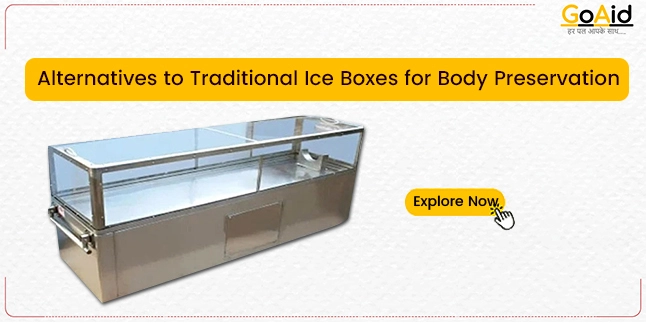In India, it’s not hard to use the Ice Box method for preserving a deceased body for a long time. However, this Ice Box method is not a reliable method for many reasons. This is why moving toward some modern solutions and methods as alternatives to this Ice Box Method is paramount. To provide this solution, we have added the required solutions and steps in this blog, and we also have explained each of them with some understandable nomenclature. After reading this blog, youŌĆÖll get to know about the Alternatives to Traditional Ice Boxes for Body Preservation. So, letŌĆÖs start-
Alternatives to Traditional Ice Boxes for Body Preservation
We have listed some of the major alternatives methods to the Traditional Dead Body Freezer Box.
1: Chemical Embalming
What is the Chemical Embalming Method?
Chemical embalming is a preservation technique that involves using preservative chemicals, such as formaldehyde. These chemicals are used to slow down the process of decomposition in a deceased body.
How does it work?
The process starts with the injection of embalming fluid into the circulatory system, replacing blood and bodily fluids. This fluid contains chemicals that disinfect, preserve, and restore the body.
Pros of Chemical Embalming
- Preservation: Effectively slows down decomposition, allowing for a prolonged viewing period.
- Restoration: Enhances the deceased’s appearance, providing a more natural and lifelike appearance.
- Time Delay: Buys time for funeral arrangements, especially if there’s a delay in burial or cremation.
Cons of Chemical Embalming
- Environmental Impact: Chemicals used may have environmental consequences.
- Cost: Embalming can be relatively expensive compared to some alternative methods.
2: Cryonics
What is the Cryonics Method?
Cryonics involves freezing the body at extremely low temperatures, typically using liquid nitrogen, with the hope of future revival through advanced medical technology.
How does it work?
The body is cooled to a temperature where metabolic and chemical processes virtually halt, preventing decay. The idea is that, in the future, advanced medical technology might be able to revive and cure the individual.
Pros of Cryonics
- Potential Future Resurrection: A speculative but optimistic chance for revival with future medical advancements.
- Preservation of Tissues: Freezing helps preserve the body’s tissues and organs for an extended period.
- Hope for Terminal Cases: Offers hope for those with incurable diseases, anticipating future cures.
Cons of Cryonics
- Scientific Uncertainty: The concept is highly speculative, and the science behind future revival is uncertain.
- Ethical and Legal Issues: Cryonics raises ethical questions, and its legality varies, creating complications.
3: Mummification
What is the Mummification Method?
Mummification involves removing moisture from the body using salts and preserving it to prevent decay, similar to ancient Egyptian practices.
How does it work?
The process includes cleaning, drying, and wrapping the body with preservative materials. This method aims to desiccate the body and inhibit bacterial growth.
Pros of Mummification
- Long-Term Preservation: Effective in preserving bodies for extended periods.
- Cultural Significance: Reflects historical and cultural practices, especially in ancient civilizations.
- Aesthetically Unique: Provides a distinctive and recognizable appearance.
Cons of Mummification
- Complex Process: Requires meticulous and time-consuming procedures.
- Limited Acceptance: Not widely practiced in contemporary societies.
Also Read: Ambulance Service FAQs: Common Questions and Answers
4: Plastination
What is the Plastination Method?
Plastination is a preservation technique that replaces bodily fluids with reactive plastics, creating durable and lifelike anatomical specimens.
How does it work?
The process involves dehydrating the body and impregnating it with a liquid polymer. After curing, the body becomes rigid and resistant to decay.
Pros of Plastination
- Educational Value: Ideal for anatomical study and medical education.
- Long-Term Preservation: Results in long-lasting specimens for research and exhibition.
- Detailed Presentation: Preserves intricate details of the body’s anatomy.
Cons of Plastination
- Complex Process: Requires specialized equipment and expertise.
- Cost: The process can be expensive and may not be practical for all situations.
5: Promession
What is Promession Method?
Promession is a preservation method that involves freeze-drying the body using liquid nitrogen, followed by vibration to turn it into powder, suitable for natural decomposition.
How does it work?
The body is frozen using liquid nitrogen, becoming brittle. It is then subjected to vibration, breaking it into small particles. The resulting powder is freeze-dried, removing the remaining moisture.
Pros of Promession
- Environmentally Friendly: Emphasizes natural decomposition and reduces environmental impact.
- Reduced Space Requirements: The resulting powder takes up less space than a traditional burial.
- Potential for Nutrient Return: The powder can be used as a soil conditioner.
Cons of Promession
- Equipment Requirements: Requires specialized equipment for freezing, vibration, and drying.
- Perceived Sensitivity: Some individuals may find the concept of vibration unsettling.
Also Read: What to Expect During an Ambulance Ride: A PatientŌĆÖs Guide
6: Hydrogel Injection
What is the Hydrogel Injection Method?
Hydrogel injection involves injecting a hydrogel into the body, turning it into a solid, rubbery substance that resists decomposition.
How does it work?
A hydrogel solution is injected into the body’s tissues, replacing bodily fluids. The gel solidifies, creating a stable and preserved form.
Pros of Hydrogel Injection
- Preservation Stability: Results in a stable and non-decaying state.
- Versatility: This can be used for preservation and as a cosmetic aid.
- Reduced Environmental Impact: Potentially less impactful than traditional embalming fluids.
Cons of Hydrogel Injection
- Limited Adoption: Still a relatively uncommon and experimental method.
- Long-Term Effects: The long-term effects of hydrogel injection on tissues are not fully understood.
7: Microbial Preservation
What is the Microbial Preservation Method?
Microbial preservation involves using beneficial microbes to break down the body naturally, promoting a sustainable and eco-friendly approach.
How does it work?
Microbes, such as bacteria, assist in the natural decomposition process. These microbes aid in breaking down tissues and organic matter.
Pros of Microbial Preservation
- Eco-Friendly: Leverages natural decomposition processes without harmful chemicals.
- Nutrient Recycling: This breaks down the body into organic matter that contributes to nutrient cycles.
- Low Environmental Impact: Minimizes environmental harm associated with chemical methods.
Cons of Microbial Preservation
- Variable Decomposition Speed: Decomposition rates can vary, affecting the overall process.
- Acceptance Challenges: Faces cultural and societal challenges due to its departure from traditional methods.
Also Read: Ambulance Services for Special Events and Sporting Events: What You Need to Know
Conclusion: Alternatives to Traditional Ice Boxes for Body Preservation
In this blog, we have gotten to know about those alternatives that can be used to preserve a deceased body for a long period. The Traditional Ice Boxes are not the only way to preserve the bodies. Using the alternatives may come with some pros and cons. We have listed those pros and cons in this blog too. This is a shareable blog. You should share this blog with your near-hearts so they can educate themselves with this precious knowledge.














